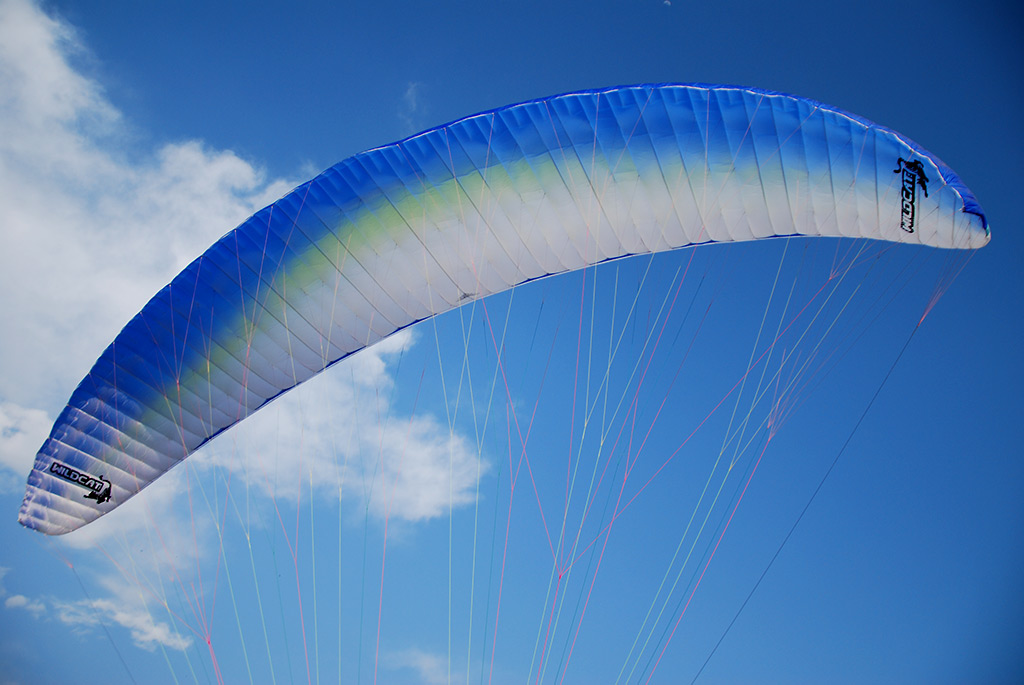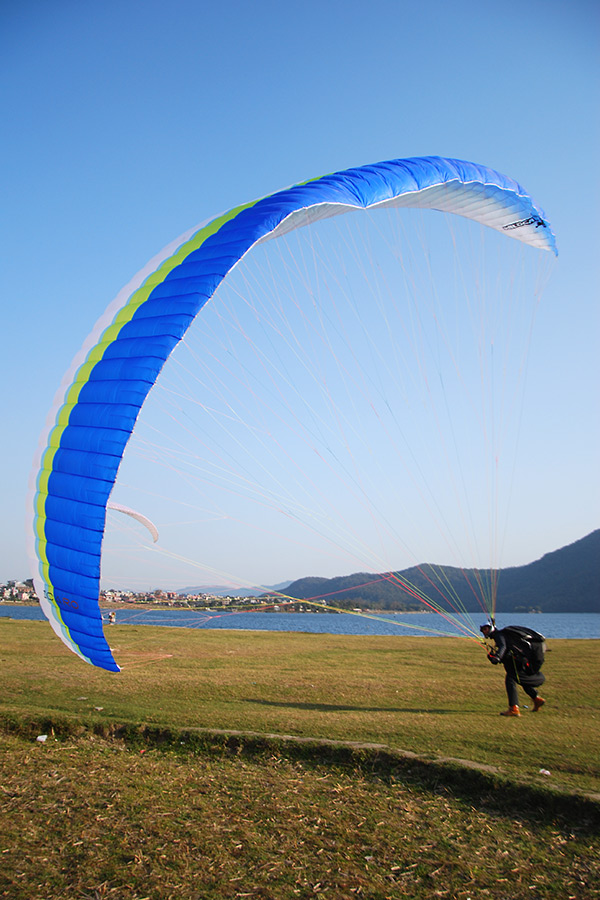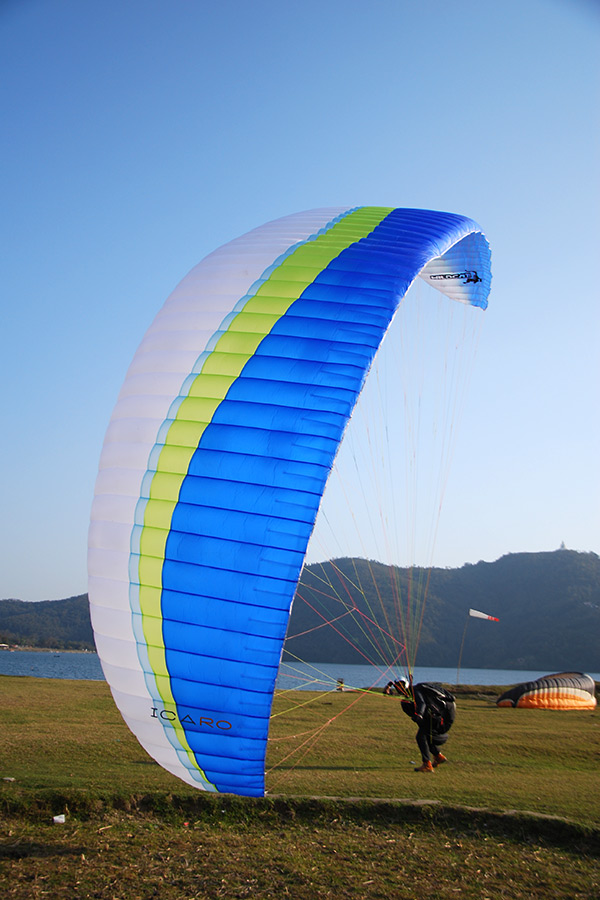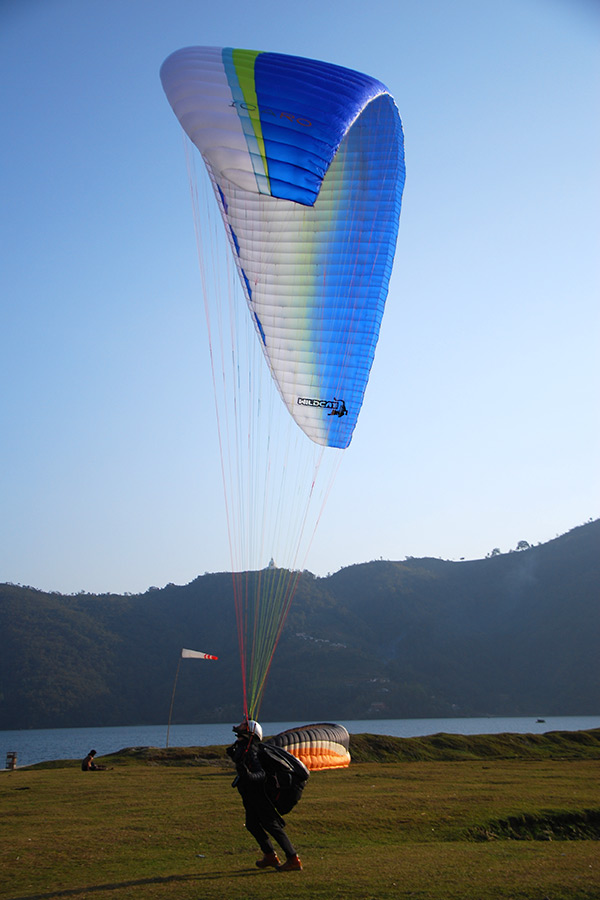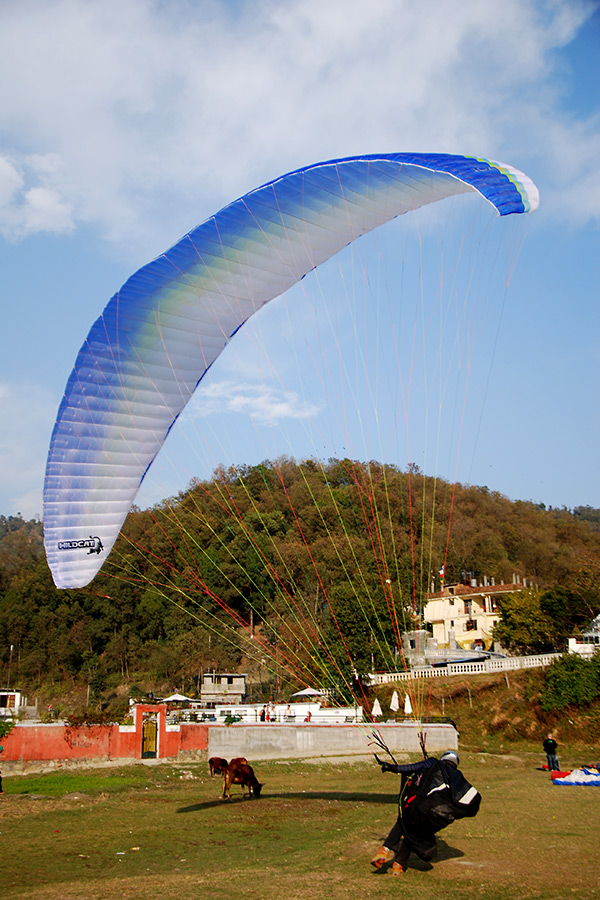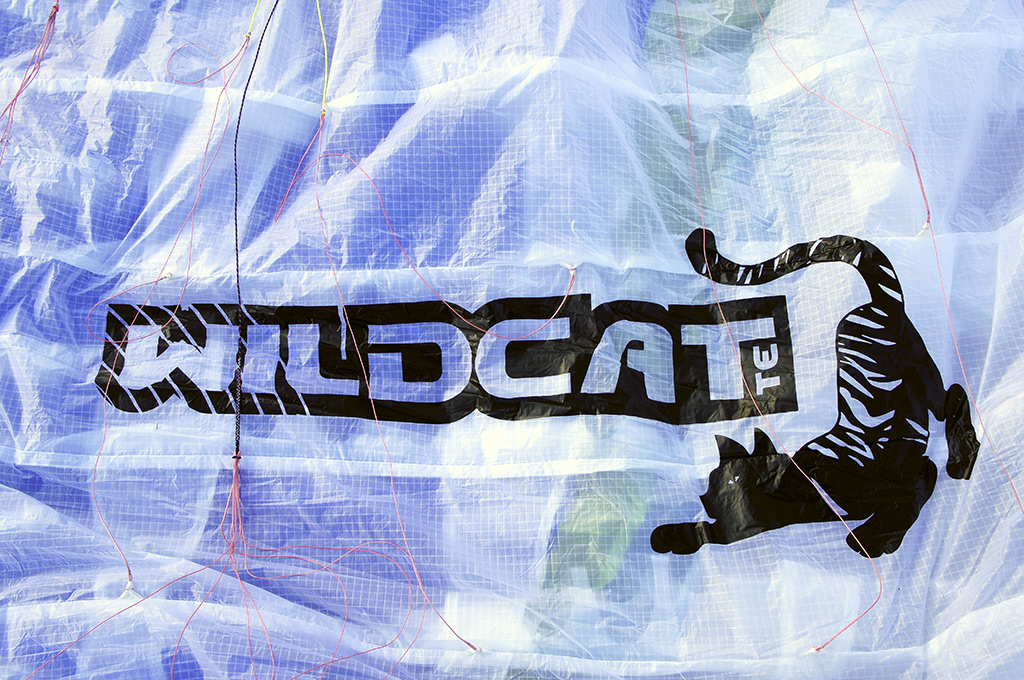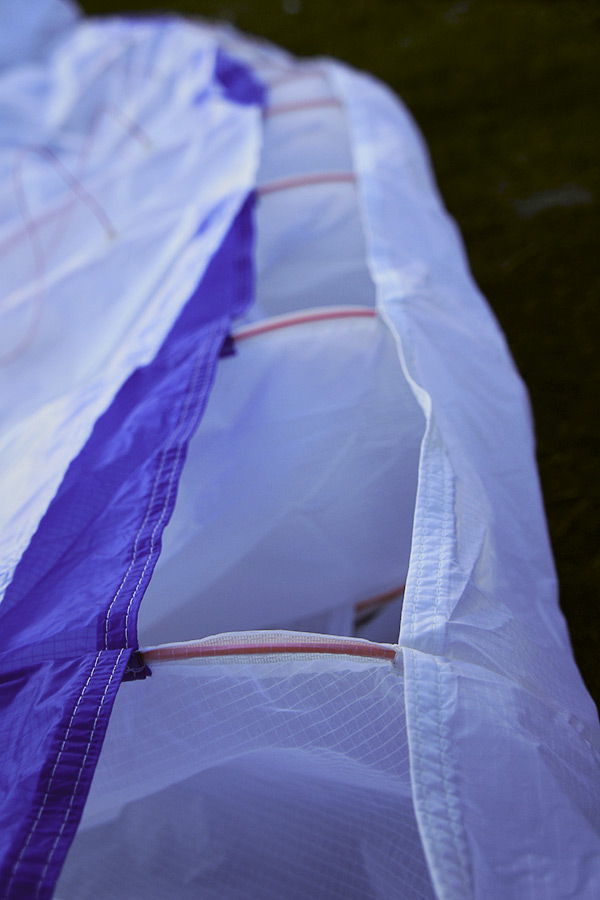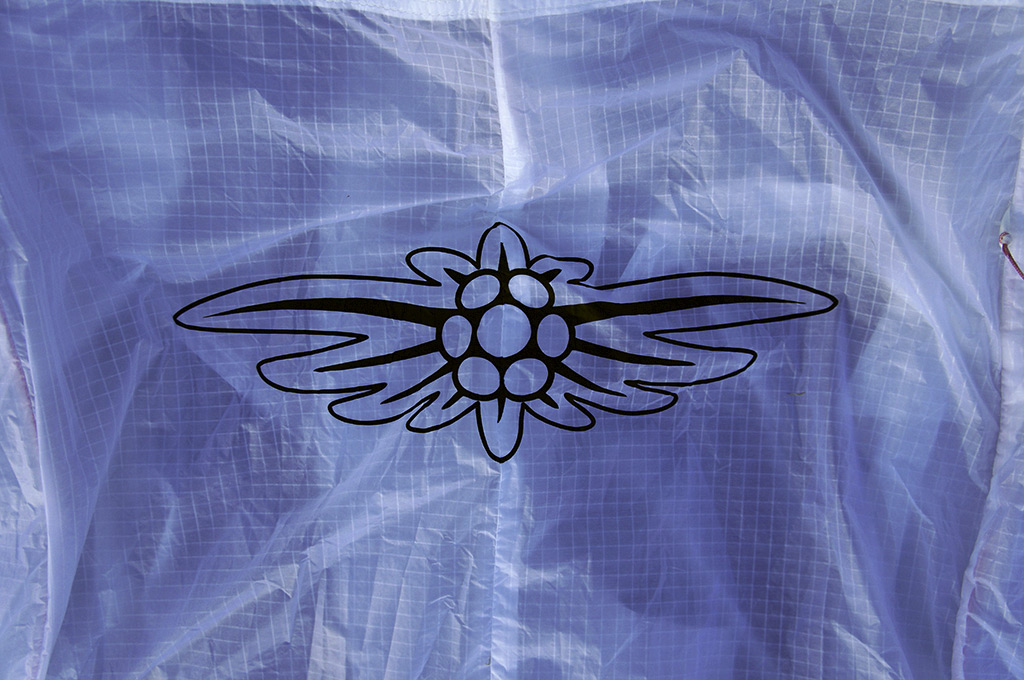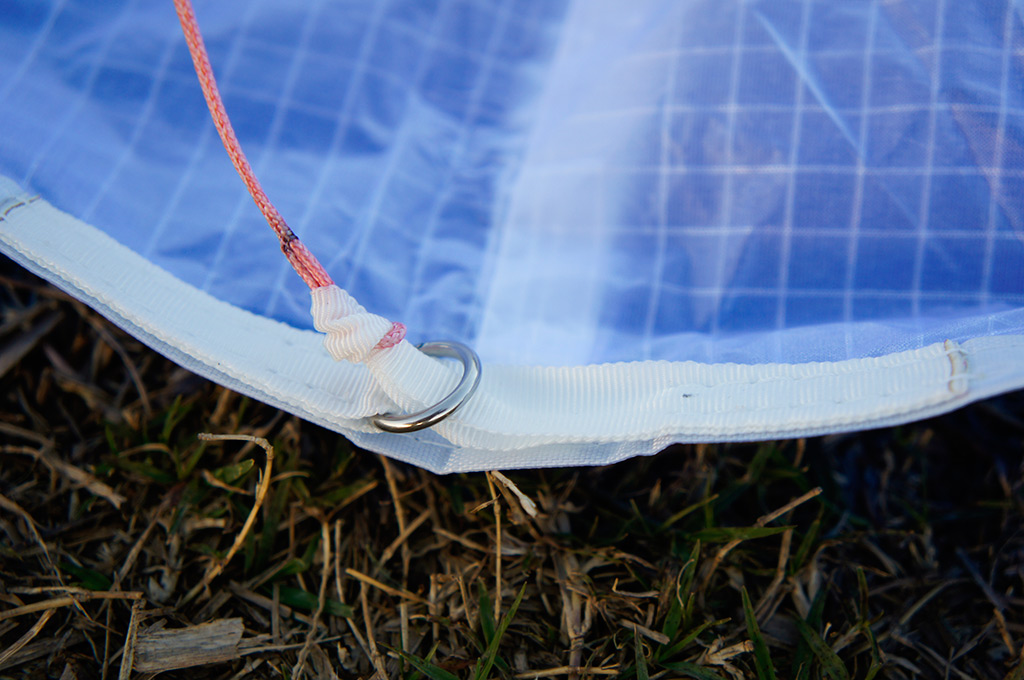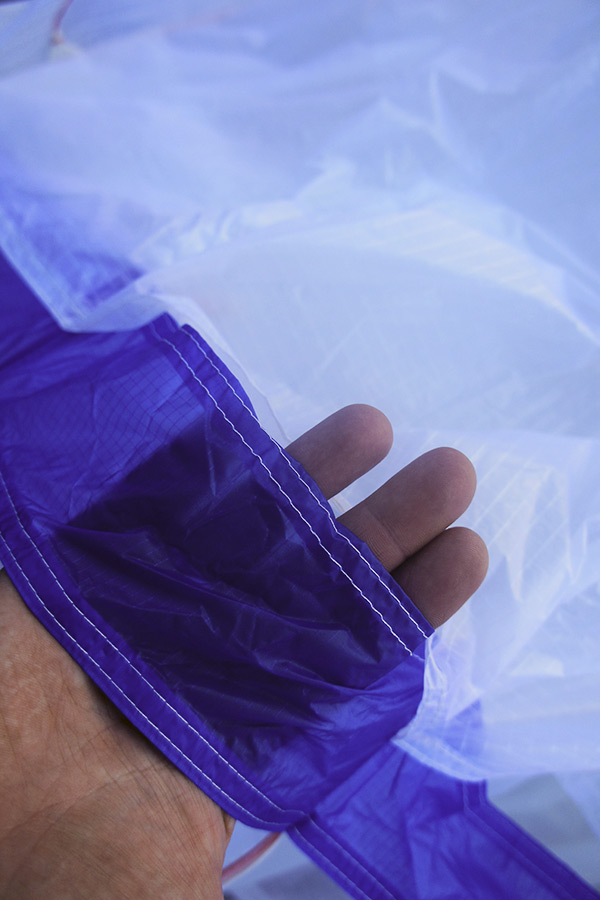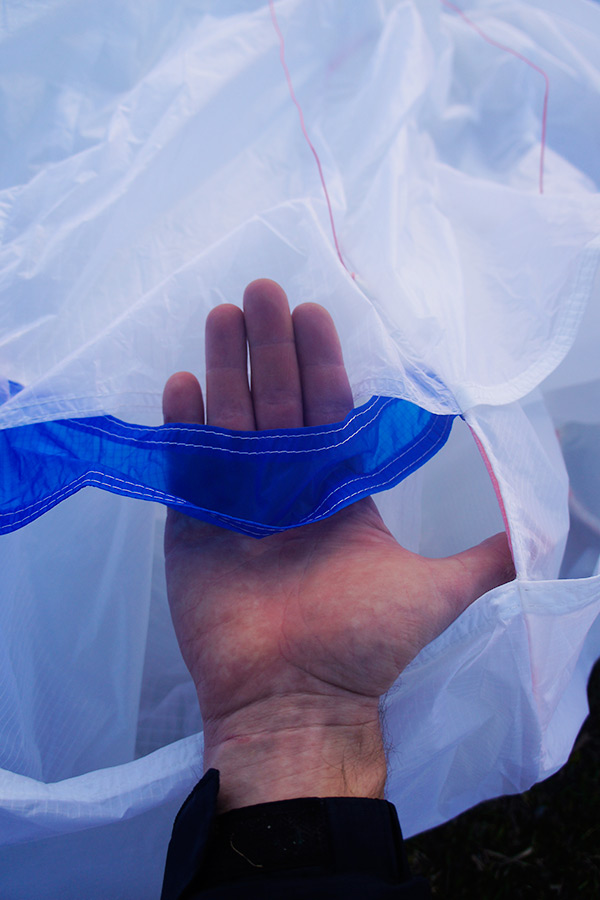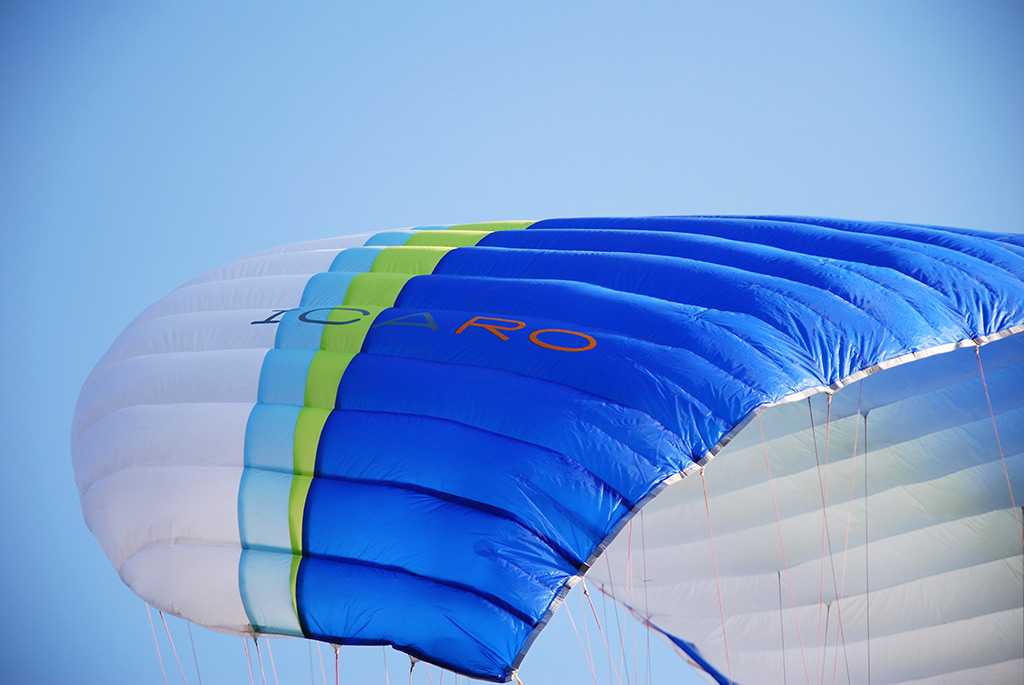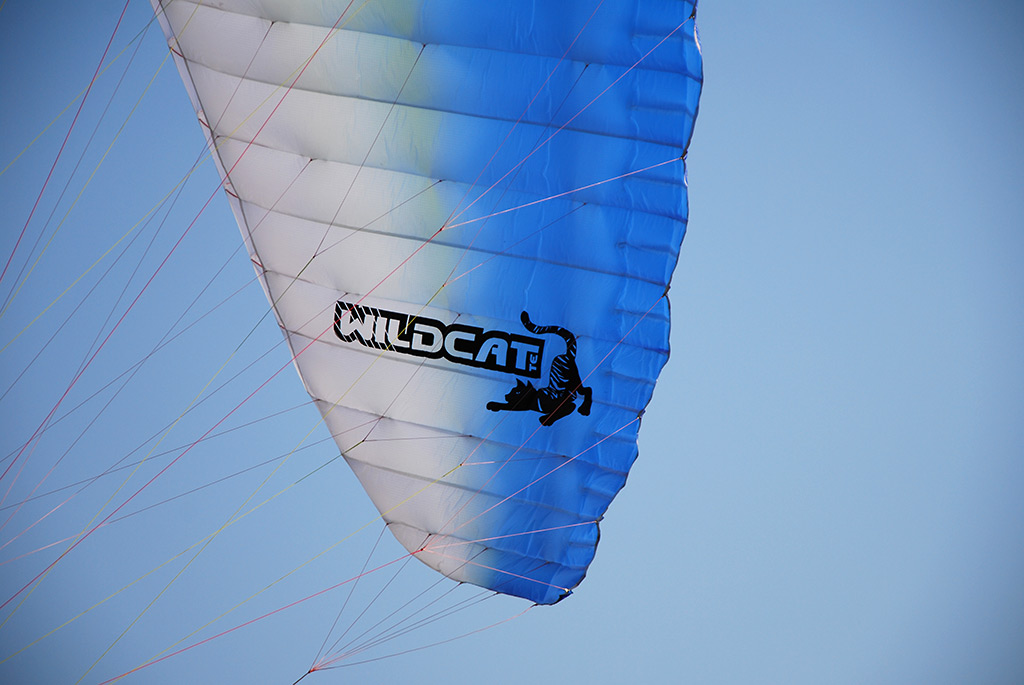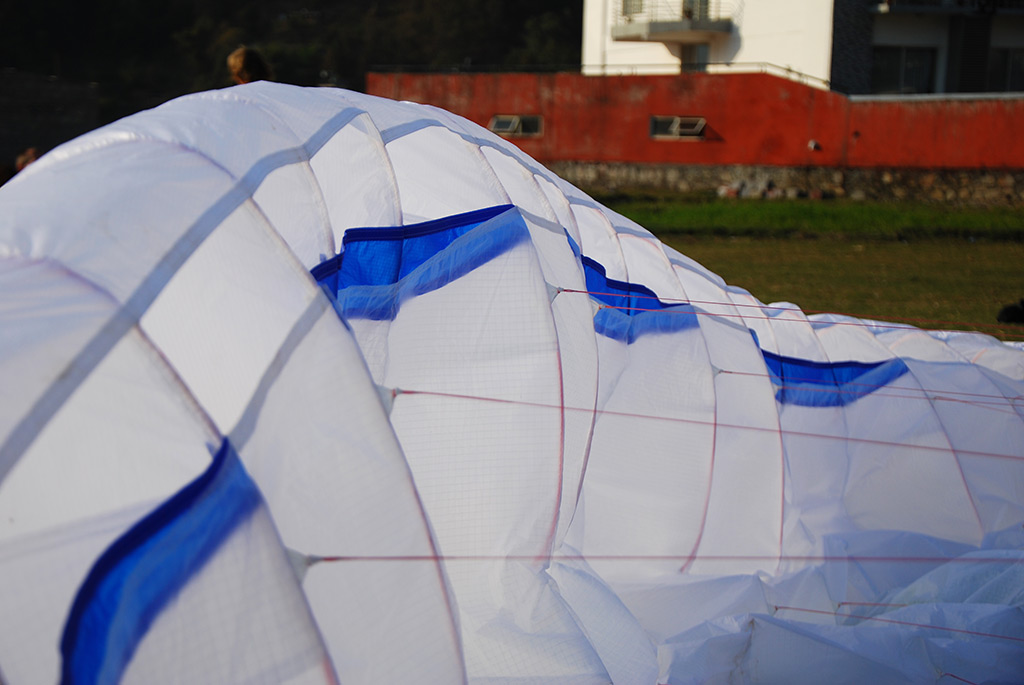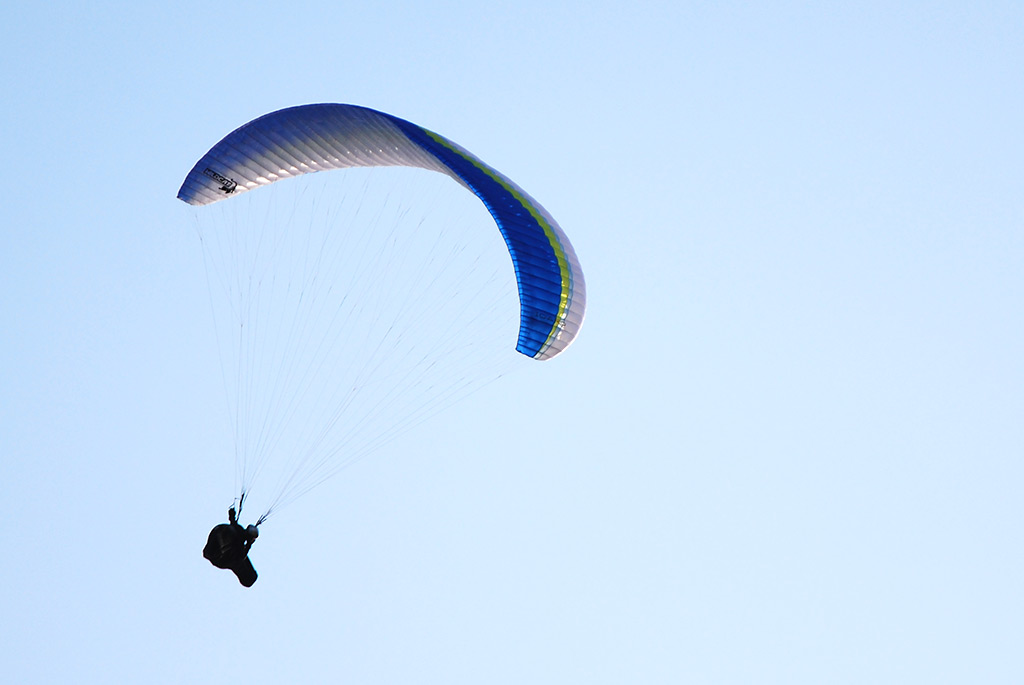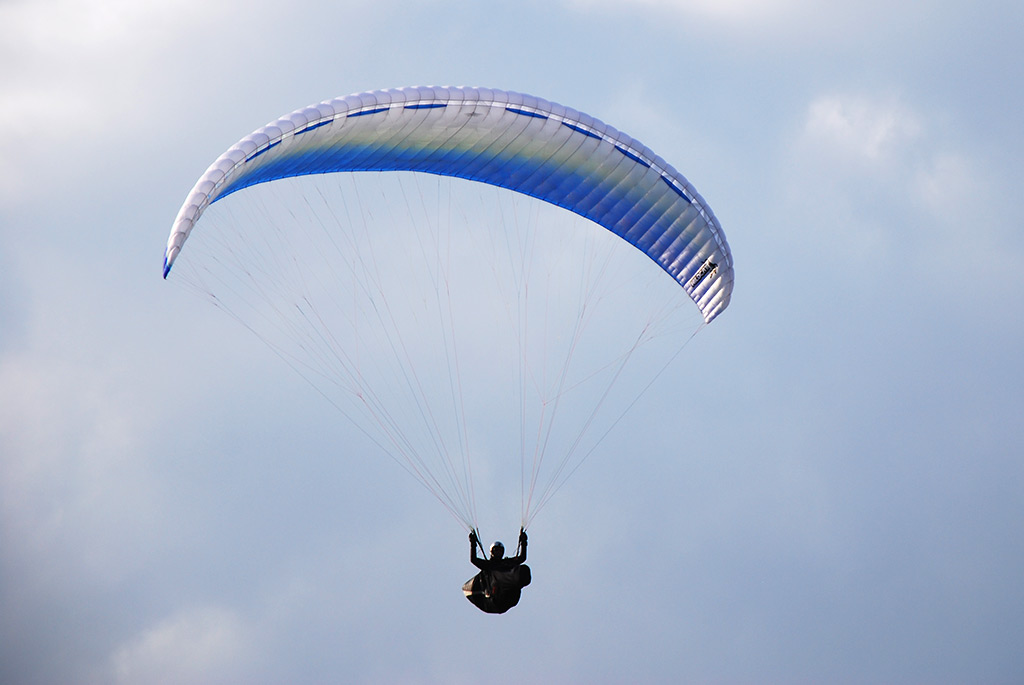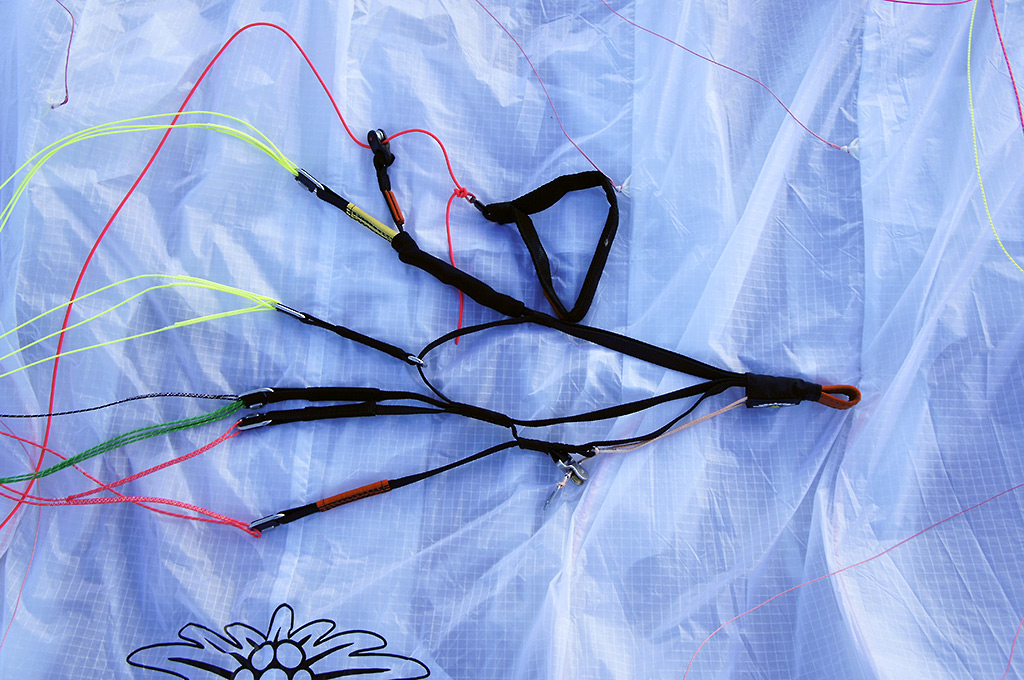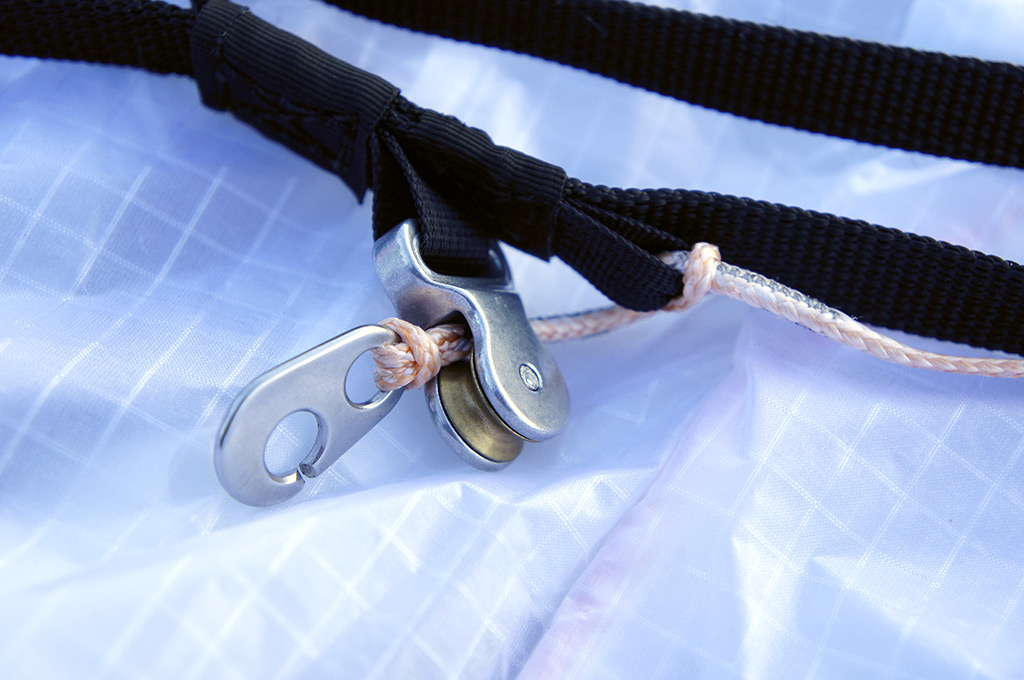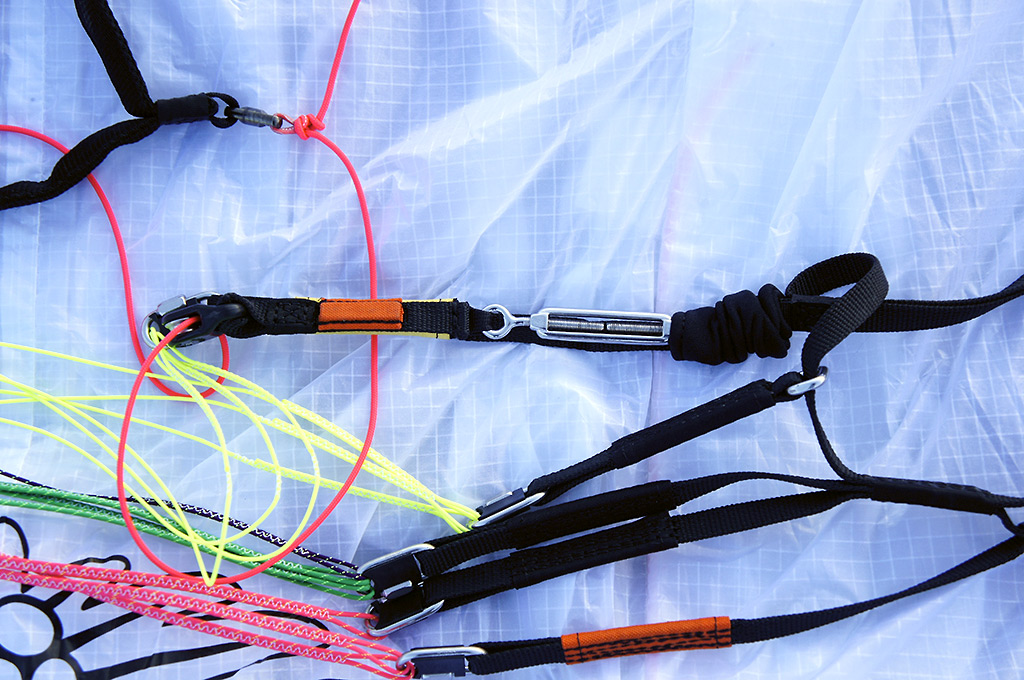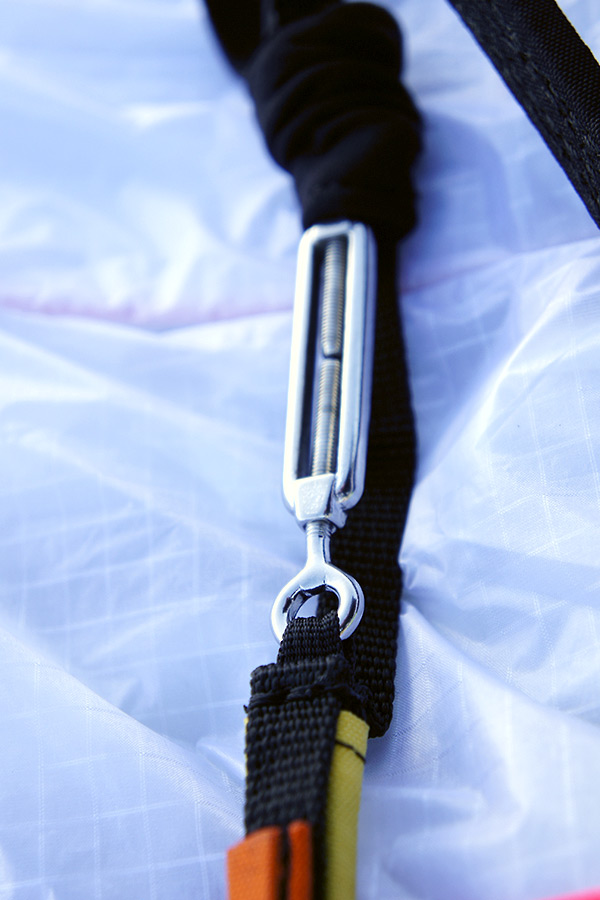Design
A peculiar mixture of tradition and innovation. The first thing that catches your eye is the flaps in the leading edge, designed to expand the range of angles of attack, at which the intakes are able to work quite well. Nowadays, such effect is more often achieved with a "shark nose" in the front profile - but we should not forget that the Wildcat was designed when the "shark nose" was just beginning to come into fashion. The shape of the wing is classic, with no miracles. The Wildcat doesn't look like an aggressive sports machine or a simplified dubolet - it's somewhere in between. Its compromise philosophy is evidenced by the braided slings in the lower tiers and the rather conservative loose ends. Apparently, Wildcat is aiming for the middle of the intermediate class.
Of particular note is the proprietary technology for fine-tuning the setting angle of attack. The Wildcat's rear rows are equipped with a few centimeters of sling travel, more than enough to compensate for the inevitable shrinkage and stretching of the slings. This solution is clearly more convenient than the usual pulling of the slings under load or putting extra loops on the connectors. What is interesting is that the fine pitch of the turnbuckle threads allows you to adjust the sling to within fractions of a millimeter - there is no practical need for such accuracy, but it is still nice. The turnbuckles themselves are small enough and protected by neoprene pouches, so you don't have to worry about the slings catching on them.
The start, work with the wing on the ground
No complaints. The glider runs smoothly with no tendency to overshoot or backwards. This is true even in the heat of the mountains. And if you play with the Wildcat on the green grass of the landing pad, blown by the smooth lake breeze, everything becomes even more wonderful. The Wildcat reacts calmly, but quickly and accurately. Even a flight-school graduate shouldn't be too worried about dropping your wingkit on the ground and bringing it back up. All in all, it's a pleasure and no trouble.
Flight
Wildcat's behavior is best described as "strange," though perhaps "strange" is just as good as "unusual. And this applies above all to behavior when entering strong and perhaps moderate thermals. In simpler conditions, the "wildcat" behavior becomes more straightforward.
Fugacity. Normal average - not more, but not less. Top speed is something like 50 km/h, maybe a bit more. The Wildcat is confidently superior to the very basic Intermediates, but can hardly compete with the Intermediates near the top of the class. With the sink rate the situation is similar - in straight flight everything is good, but starting from the roll of 40 degrees the plane begins to slightly, though not critically, "fall apart". This does not create any problems when flying, you just need to watch the airspeed a little more carefully than usual, and do not forget to brakes the machine with the external helix hand.
Maneuverability. It's OK. Just right for a fresh out of flying school, which means that there is a certain lack of refinement in piloting technique. On the one hand the Wildcat reacts smoothly with its hands, without the sharpness of a top-of-the-line Intermediate. On the other hand the lack of sharpness means that it can forgive and smooth over piloting errors that are understandable and forgivable for a typical day sailor. Reaction to the brakes is not without some peculiarity, which is expressed by the complex nature of changes of load on the arms as the arms are lowered. In general, however, the brakes are moderately loaded. The Wildcat weight response is also quite calm, and this is probably a plus. The Thermal Helix is a bit more complicated than usual, as it is a bit delayed and the transition is a bit tricky, but I don't think the typical wing owner would really notice that. In a thermal spiral, the Wildcat stands well, convincingly, and holds it securely, not tending to fall out of the flow. The radius of the spiral and the roll change in a comfortable, smooth rhythm. The plane does not force a certain piloting style and reacts to any pilot actions calmly and predictably. In strong and narrow mountain thermals, however, this kind of steering response may not be to everyone's taste (especially experienced pilots) - in strong weather, a sharper steering response would be more appropriate.
Comfort and informativeness. Perhaps the strangest thing about the Wildcat. I suspect it's mostly the fault of the dampers, which are generously outfitted on the leading edge of the subject. On entering the stream, the Wildcat starts crunching the flaps menacingly, which is a little scary at first, but not dangerous. More unpleasant is Wildcat's tendency to briefly peck forward immediately after entering the stream. This is atypical behavior - usually the glider flaps backwards when entering the stream, but Wildcat is not like that. And that's not all. The roll amplitude seems to be small, but leading edge is unloaded so much that it may even get to a slight collapse in especially heavy streams. It's not too unpleasant in itself - what's unpleasant is the atypicality of such behavior, which will be unusual for more advanced Wildcat pilots and may result in less experienced pilots developing piloting skills, which will be of no use when switching to more traditional jet flying techniques. Rumor has it (confirmed by video) that in very strong weather the Wildcat is prone to sudden "frontals", which unfold as quickly and unexpectedly as they appear. Nothing pleasant, but due to the rapidity of the opening it is not a big problem even near the terrain. Once again, I should point out that problems with unexpected folds only appear with Wildcat in strong weather. The only flight I made on this wing in flat conditions showed no such problems.
The information capacity of the test wing is probably above average, the crunching of the valves alone is worth it! Pitch and yaw motions are strong enough on the Wildcat, but a bit less so on the brake and trim. I'll say it again, the behavior on the in-flow is a bit strange - the atypical dynamics of pitch motions is a bit confusing and takes some getting used to, but it gives a lot of information to the pilot.
Dynamics and power capacity. Above average for an after school wing. However, this does not threaten the after-school pilot with any trouble, due to the subject's rather calm character. Wildcat easily gets itself into a tight spiral or a roll of over 90 degrees - but such drastic maneuvers require some effort from the pilot and do not start instantaneously. Landing with overrun is possible, but again requires the pilot to be persistent and clear in his communication with the machine.
Rapid descent modes
"Ears."
Good with a plus. Not as good as "excellent" due to low efficiency, not even down to -2 meters per second. But the mode is very stable and comfortable, which is not always the case nowadays. Mostly they open by themselves, but you may need a little help with the brakes.
gas pedal "ears"
The reduction goes up to about -2.5. No change in the grade.
Hazardous modes of flight
Asymmetric collapse
Excellent. Looks like the second generation of wings with the wires in the leading edge has finally made history with the problems with sharpness and unpredictability of the exit from the folds. Folding the Wildcat is not difficult, the leading edge breaking force on the A-row is moderate. Along the chord, the fold is shallow, about 30%. Folding at 50-55% opens smoothly, gradually, from the center wing to the "ear" - which is good, because the opening from the "ear" to the center wing often proceeds with unpredictable pinches and course deviations. The oblique pecking does not exceed 45 degrees, the course deviation does not reach 90 degrees. The only thing to complain about is a slightly greater than usual loss of altitude on the mode (15-20 meters). The behavior of the aircraft at the exit from the fold is in general quite calm.
Asymmetric superset on the gas pedal
Only the angle of departure changes noticeably from 45 degrees to approximately 90 degrees. The amplitude of the oblique roll, oddly enough, almost does not increase. Loss of altitude is about the same as in "asymmetry" without the gas pedal. Overall, the mode runs surprisingly smoothly and smoothly - especially if you remember the lines in the leading edge.
Frontal folding
Somewhere between "good" and "good-minus." The leading edge breaks quite easily, and the depth of folding along the chord depends on the sharpness and strength of the tug behind the A-risers and ranges from 30 to 70 percent. When folded, the Wildcat goes back sharply and strongly, and then "hangs" distinctly, taking the time to peck forward and gain speed. The opening is leisurely, but gentle and smooth. The loss of altitude on the mode can be up to 30 meters; in my opinion, this is a rather high price to pay for the calm character of the opening. Note that Wildcat's "combat" frontal folds are characterized by a shallow depth of development along the chord and a quick exit with little loss of altitude.
Thermal Spiral Blast
Excellent with a minus. The minus is for Wildcat "slippage" in thermal spirals, which can be confused with a sub-collapse if you're flown hard. The Wildcat's subcrash is quite achievable - the inner arm travel at the stall is not as monstrous as in most modern intermediates. The force on the arm at the edge of the stall is also great, but not excessive: it is not difficult to "squeeze" the threateningly heavy bracket. Breakdown starts with several sections at the ear and does not have time to spread to the whole bracket at the first second of the breakdown. The load on the inner hand is noticeably reduced. In general, it is not difficult to provoke the mode, but it is not difficult to notice the hit in the mode. In the first half-second or second after the subcrash, releasing the brake causes a moderate oblique flip; the unit accelerates strongly, but remains in the thermal helix.
Opinion of Mikhail Arzumanov, Head of Flight School "Vector-Kaluga
I as an instructor was most interested in who the wing was made for and who I could recommend it to. It is not an outright overdemphasized after-schooler, but it is not a forced chucked into this class, either, who has been "taught" to fold up quickly. Really the middle of the class. Of course, to a newly graduated basic graduate, I wouldn't recommend grabbing it and flying into the big mountains in the spring. Not that it will kill you, but it might scare you. It would be better to get used to it on a plain ground beforehand. I liked very much the turnbuckles from design features. You can adjust the device very finely. At first it seemed that the wing lacked speed. When I let go of the wing by two or three centimeters, here is the desired result.
Takeoff. Dull and straightforward without any flaws. To touch the ground and back without any problems, controlling every centimeter of the process.
Flight. Glide - okay. Speed - okay. Maneuverability - just right for a runaway. Informative, sometimes overdriven. In the flow requires more attention and concentration while controlling than I would expect from the vehicle of this class. However, maybe I'm behind the times, and most modern ENBs behave the same way. I haven't seen any systematic frontal collapses when entering nepal streams, maybe because I weigh 10kg more than the Theoretic and have loaded the wing under the top of the fork. The valves do rustle in the thermals pretty much all the time, which you get used to very quickly. Load on the brakes is comfortable. Response to steering movements is adequate. Weight control is not abrupt and linear. The unit willingly stores energy, but the control allows you to "smash" its surplus without any problems if you want to. Entering the steep coil at my load without any complaints, maybe a little slower than expected. The exit is quite comfortable, without flings and flops, if you have the technique, of course. When you perform wings with a serious amplitude you need a little more attention and depth of work with the brackets to avoid unloading the cantilevers.
"Very comfortable, very stable, no problems. They open on their own. Decrease of course, but not so much.
gas pedal"ears" significantly add reduction and speed. I had a case of "combat" use, when I was sucked into a cloud. It worked for five points. I was able to catch up with my classmate going ahead of me half a kilometer away.
Gas pedal was a real delight. Even at half-pressing the helmet made so much noise that it was impossible to understand what was being said over the radio. I had some frontals when the speed-bar was fully depressed, but they opened amazingly fast, if you let go of the pedal.
Asymmetrical folding. Exit is an A. Even an A-plus. In combat, you don't often have time to see this output, as everything happens very quickly.
Conclusions
What you call a ship, that's how it sails. I think that the Wildcat TE was right on the mark in this respect. "Wildness" in this machine is definitely present - in strong conditions Wildcat is prone to unexpected (though quickly revealing) folds. It can scare you, but it's unlikely to cause more serious problems. The Wildcat's zest is a rare combination of high power capacity and fairly high damping. This may not be to everyone's taste, but the Wildcat will certainly find its buyer. I estimate the minimum flight time required at 20-25 hours. Because of its relatively calm nature and moderate maneuverability the Wildcat is better suited for foothill and lowland flying; for mountain flying it is desirable to have a sharper and more accurate control... and if possible does not fold up unexpectedly for the pilot.
Pros of
- The possibility to set balancing mode very accurately
Cons
- Peculiar behavior on entry to the flow: unloading the leading edge and increased likelihood of folding
I thank the Icaro dealer in Russia Alexander Tronin for providing me with a paraglider for testing.
Photo: I. Tarasova, A. Tarasov


